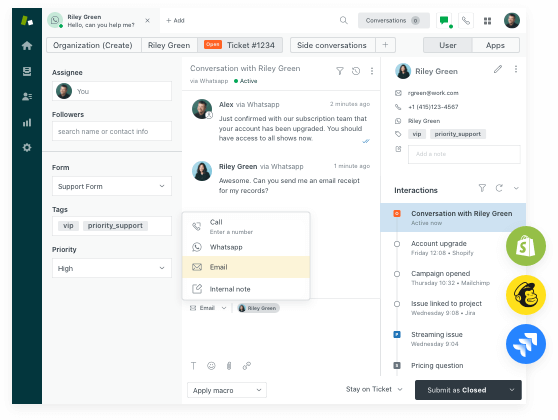Knowledge base software
Get ready to create, organize, and share knowledge base articles and content easily with customer support agents, select customers, or the public—and measure what performs best.

A guide to the best knowledge base software
Knowledge base software is increasingly vital to the modern customer service team’s ability to deliver excellent service. But no two teams are exactly alike.
And what makes one system the best knowledge base software for one team doesn’t always translate for others. So the onus is on you and your team to decide which tools are the best fit for your customers and business.
To help you with that, we’ll start with the basics of knowledge base software: what they are and how to create one as well as their top benefits and essential features. Then we’ll overview 15 of the best available knowledge base tools.
To wrap up, we’ll walk through how to think about choosing the ideal knowledge base software for your organization.
Feel free to skip around by clicking through the table of contents below:
- What is knowledge base software?
- What are different types of knowledge base software?
- How do you create a knowledge base?
- What are the benefits of knowledge base software?
- What are the essential features of a knowledge base software platform?
- Top 15 knowledge base software
- A comparison chart of top 15 knowledge base software
- How do you choose the right knowledge base software?
- Frequently asked questions on knowledge base software
- Try knowledge base software for free
What is knowledge base software?
Knowledge base software is a tool that helps businesses gather, manage, and share important internal and external knowledge in an organized and searchable format. When creating a knowledge base for customers, the goal is to produce a centralized directory of content about your products or services and how they are used. For your employees, a knowledge base is an important tool for distributing information about systems, processes, and policies.
This means your knowledge base software needs to be an intuitive, simple solution that lets you both organize and distribute information. Different types of software will provide templates, formatting, and data hosting for your content. Others may provide categorization, full-text search, and self-service portal capabilities for your customers. The most convenient knowledge base software tools will seamlessly integrate with your preexisting customer support and CRM platforms.
Your knowledge base software should help you create a time-saving, user-friendly archive that you can point to whenever anyone – customer, partner, prospect, or employee – asks, “Where can I find out more about that?”
What is the purpose of knowledge base software?
The purpose of a knowledge base software is to provide information that will enable your customers to have a better experience using your software or product. Knowledge base software also makes agents more efficient by providing customers with self-service options for simple tasks.
How does knowledge base software work?
The most basic knowledge base software works by helping you organize your institutional knowledge and put it to work as useful content in a searchable database. More advanced systems take it a step further using automation and machine learning to automatically offer relevant articles from the database in response to customer inquiries.
Typically, knowledge base software is configurable so your database is private, public, or a bit of both. Private databases are only accessible by logged-in users. Public ones are accessible by anyone via search engines. And a database that’s both public and private would have some content only available to logged-in users and some content available to everyone.
Why is knowledge base software important for your business?
Knowledge base software, both external and internal (customer-facing or for employees) are crucial to your business. One of the biggest issues companies face is siloed information, in other words, data that is known by just one team or often just one person. Without access to that data, a business can’t function optimally, especially if knowledgeable employees leave the company.
A well-managed internal knowledge base can make every part of your business run better. Customer support will be able to access and create content that boosts efficiency and results in better outcomes for consumers; product development can use the knowledge base to track feature requests, common customer complaints, and information about legacy code; and human resources can use the base to keep employees informed.
Meanwhile, an external knowledge base software—one your customers can access—provides essential self-service options. Most customers prefer to be able to solve problems on their own rather than contact customer support, and a knowledge base serves this purpose quite well. From onboarding customers to your product or service to pages that explain your offerings to potential clients, a knowledge base can set your business up for success.
What types of data are provided in a knowledge base?
A knowledge base can offer users a wide range of information. For customer-facing knowledge bases, the data can include:
- FAQs
- Troubleshooting guides that feature detailed steps toward resolving issues
- Onboarding flows that help customers
- Product and service descriptions to give potential clients a clear understanding of your company’s features
For internal knowledge bases—ones employees use to get their work done—data can cover a huge range of subjects.
- Support teams can use knowledge bases to document problem-solving so agents don’t have to reinvent the wheel. A knowledge base is also a great way to keep track of best practices and other team information.
- Product organizations can lean on a knowledge base to prioritize and track feature requests and document product development.
- A knowledge base is a handy tool for human resources departments to communicate essential internal information to employees, such as company policies, holidays, and best practices.
What is the difference between a database and a knowledge base?
Think of it like this: a database stores raw data, whereas a knowledge base is a curated collection of articles that serve helpful information to users in the form of articles. A knowledge base, unlike a database, makes it very easy to access and digest information about specific topics and problems.
What are different types of knowledge base software?
For a company that’s just starting out, a “knowledge base” may be as rudimentary as a shared Google Drive containing PDFs of product specs, customer FAQs, and employee manuals. But as a company expands, this can create issues with security, searchability, and accessibility.
As mentioned before, knowledge base needs tend to fall in two categories: internal and/or external.
Internal knowledge base software is only accessible to company employees, and stores private information relevant to staff. External knowledge base software is a compendium of product and company knowledge that is meant to be shared with external stakeholders and/or customers.
Knowledge bases also differ based on where the data is stored. Documents can be hosted on company servers or hosted on external servers. One common type of external hosting comes from SaaS (software as a service) providers, who will securely store a large amount of data for a monthly subscription fee.
The following are common types of knowledge base software:
Intranet software
Intranets are privately owned and accessed communication networks that make internal information-sharing and communication simple. They’ve been around for decades, and for good reason: they are extremely valuable for sharing company-wide information in a secure fashion. On the other hand, they’ve been around for decades, and don’t tend to be easily searchable, intuitive, or mobile-friendly. They’re also almost always exclusively for internal communications.
Wikis
Like the ubiquitous Wikipedia, a wiki is any documentation portal that contains a searchable directory of user-sourced information. Smaller companies may find wikis a workable knowledge base solution for internal and external needs. While community-built wikis exist for any number of products, software, and games, using (or leaning on) a wiki to be your primary source for customer information has major drawbacks. You’ll have a tough time ensuring consistency and separating public and private information. Moreover, you’ll have no access to analytics – an important CS tool for tracking FAQs and product issues.
Dedicated knowledge base software
A specialized and customizable tool for creating, sorting, maintaining, and sharing vital internal information that comes as an enterprise piece of software. These score much higher on mobility, searchability, and ease of use, and can be applied to external and internal knowledge management. However, they can be prohibitively expensive, and may not always integrate smoothly with other business software.
Knowledge base software integrations
This type of knowledge management tool integrates smoothly with larger CMS platforms. Whether an add-on to a comprehensive system like Zendesk, or working through AI to seamlessly pull omnichannel information from Slack, emails, and your CRM, this type of knowledge base software is the 21st-century solution to an age-old problem. When external knowledge bases are integrated into a larger customer support platform, your customer support team can easily turn tickets into documentation. You’ll have cross-team access to valuable analytics, company-wide SME input, and a secure, customizable, all-in-one solution to your business knowledge management needs.
How do you create a knowledge base?
The size of your team, the type of your business, and whether you’re creating internal or public-facing content affect how you create a knowledge base.
That said, having helped thousands of Zendesk users create their knowledge bases, we have a few best practices you can follow:
Assign ownership of the knowledge base
Whether their sole job is managing the knowledge base or they wear many hats, you need one person to take the lead on the KB. This person’s job is to be the contact for the team and oversee content creation. The KB owner should also regularly monitor and check the list of issues that need KB documentation.
This helps ensure that new content is created promptly and that existing content is up-to-date. In Zendesk’s knowledge base, KB owners can use views to get a snapshot of KB issues. They can then prioritize, schedule, and assign content accordingly.
Having a KB owner is also a great way to make sure that your content is consistent and thorough.
Establish a process for identifying knowledge base issues
Since support agents deal with customer issues firsthand, they’re an invaluable source of insight into what should go in the knowledge base system. So it’s key to create a process for agents to flag issues that require new or updated documentation.
At Zendesk, our Support team uses a specific tag to flag tickets with issues for the KB.
If you choose to implement this kind of workflow, remind your agents to search the existing documentation to avoid creating multiple versions of the same issue. When there is existing content, the agent should check to see if it needs updates or improvements, and flag it if so.
After a while, this will become a standard support process, and agents will identify content needs naturally and according to demand.
Designate writers for your KB
Creating KB content has to be a priority, and part of the regular responsibilities for specific people or a group. But if you don't designate writers for your knowledge base, no one will write.
Who you designate depends on the nature of the content in your knowledge base and your available resources. Some teams hire dedicated technical writers to create their content while others designate members of the support team. Other teams might have subject matter experts or even support agents as their writers.
Whoever you choose, they don’t have to have "writer" in their titles. But regularly updating the knowledge base should be part of someone’s regular job duties.
Establish editorial standards and processes
Regardless of who is creating the content, knowledge base articles must be clear, concise, and consistent. But consistently clear and concise content doesn’t happen without a solid editorial process. So you’ll need a set of editorial standards and processes to ensure your content meets certain quality requirements.
Here are a few best practices to incorporate into your processes:
- Develop a template for your articles with designated sections to fill in, so that authors include the right information.
- Link-related articles to show relationships and help users find all the information they need to solve their problems.
- Define terms and jargon, or point users to a glossary that defines key terms for your product or business.
- Schedule an SME(s) to review articles for accuracy and thoroughness.
What are the benefits of knowledge base software?
Consolidating your institutional knowledge in a single database accessible from anywhere on the internet is a major competitive advantage.
Here are four of the top benefits that—when used well—knowledge base systems provide:
Enhances customer experience
The 2022 Zendesk Customer Experience Trends Report confirmed that customers value self-service as essential to a good customer experience. While this isn’t particularly surprising, since we’ve known that customers prefer to self-serve for simpler tasks, such as changing their password, it does indicate what customers want. And in this way, through self-service, knowledge management systems directly improve the customer experience.
Improves agent efficiency
With a well-organized IT knowledge base, agents can quickly find resources relevant to their customers’ problems. And, when integrated with chatbots, knowledge bases can answer questions automatically, reducing the time agents need to spend on simple, repetitive issues. Plus, knowledge bases provide additional context that allows agents to better assist customers one on one. In short, knowledge management software makes customer support agents more productive.
Breaks down internal silos
Think of every time you contacted someone within your company for information. Now think about how much easier it would be if you could find that info yourself. Not only does a self-service option save you time, it also saves your colleagues time. This is what an internal knowledge management system provides because it surfaces information throughout the organization, across teams and geographies.
Always time for information
Since a knowledge base is always on, you can provide your customers, users, or employees with the information they want, when and where they want it. This enables your users to get help and support from your company even during holidays and off-hours. And assuming your system includes access rules, you can decide which users can access information in your knowledge base.
What are the essential features of a knowledge base software platform?
The basic function of knowledge base software is to make it easy for support teams to create and share useful content with their customers. As simple as that sounds, there are several essential features involved in this basic function.
To help you compare different tools, here are five critical features of knowledge base software:
Search engine
While it’s important to curate well-structured categories of information in your knowledge base software, most people won’t use your categories. Instead, they’ll use your search bar. If yours isn’t intuitive or doesn’t surface the information your customer needs, they’re more likely to leave or submit an unnecessary support ticket.
Feedback and analytics
The best knowledge base software doesn’t just help your customers learn about your product or service. Through feedback mechanisms and content analytics, knowledge base systems also help your support agents and managers learn about how your customers use your product. If your software doesn’t have built-in analytics or feedback, check to see if it integrates with apps that provide those features. Without feedback and analytics, you’ll lose the chance to improve your knowledge base content and your customer service, over time.
Content management
Content management features are the ones your writers, editors, and administrators use to create, revise, schedule, and publish content to your knowledge base. Because so many different people rely on these features to create knowledge base content, your software’s content management must be intuitive. After all, the easier it is to create, update, and manage content, the more likely it is that your team will actively manage your KB content.
Artificial intelligence and machine learning
Knowledge base software solutions equipped with machine learning get smarter with time, improving the quality of the automatic responses served up with AI. Other technologies streamline the maintenance and upkeep of the knowledge base, prompting contributors to update articles, fill knowledge gaps, or verify content’s accuracy and relevance.
How these technologies continue to enhance KBs remains to be seen. What’s certain is that AI and machine learning are essential technologies for modern knowledge base tools.
Self-service portal
Changing a password or printing a return label shouldn’t require one-on-one support. But without a self-service portal, your agents will be forced to field questions and deal with issues that could’ve been easily resolved by the customer on their own. So if you opt for a knowledge base system without a self-service portal, keep in mind that you’ll lose out on many of the time-saving, service-enhancing benefits of self-service.
Top 15 knowledge base software for 2022
-
Zendesk
-
Wix Answers
-
Intellum Platform
-
Bloomfire
-
USU Knowledge Center
-
Guru
-
Stack Overflow for Teams
-
Zoho Desk
-
Document 360
-
Notion
-
MangoApps
-
HappyFox
-
Slab
-
Confluence
-
Slite
1. Zendesk
Zendesk offers knowledge base software that is simple to customize and use - as either an internal knowledge base, an IT knowledge base, a support agent-only knowledge base, or a customer-facing FAQ tool. And because it’s always available, customers and support agents can use the self-service portal to find the right information whenever they need it.
Zendesk offers a lean, confident content solution
Build out your knowledge base without sweating the details. Drafts save if you’re in the middle of a work in progress, rich formatting makes articles easy to read, and you can use pre-made templates to maintain content structure. And if you’re building an internal knowledge base, content can easily be restricted to just certain groups.

Know how your knowledge base changes
Understand how your knowledge base content evolves over time. Get a list of events, so you can always be up to date with the latest changes, preserving the integrity of your content.

Speak the customer’s language
Zendesk makes knowledge management software that’s simple to use and accessible for everyone. And the freedom to translate your articles into over 40 different languages provides a localized experience that’s right for each customer.

Continuously improve knowledge with a feedback loop
Know what users are looking for and whether they're finding the right answers with built-in reports. Zendesk’s knowledge base software provides insights to expose gaps in content and helps identify areas where you need to create new KB content.

Pricing
Starting as low as $49/agent per month, Zendesk’s knowledge base software is just one of the industry-leading tools you’ll be able to access in its comprehensive suite. Plus, you can try Zendesk free for 14 days to ensure it’s the perfect all-in-one solution for your business.
Features
- Customizable branding
- Categorization
- SEO
- Content management
- Full text search
- Self-service portal
- Customer feedback
- Analytics
- AI and ML-enabled bots and search
- Community forums
2. Wix Answers

Before Wix Answers, there was (and still is) a product named Wix which was designed to enable small businesses without technical resources to build a website. Wix Answers is based on a similar value proposition; to provide intuitive knowledge base software for small to medium-sized businesses. Wix Answers is completely cloud-based and provides two different subscription plans.
Their knowledge base software is available for $19 per user per month. And for an additional $11 per user per month, Wix Answers also provides Call Center, Live Chat, and Ticketing System features.
Pricing
Wix Answers is available for $24/agent per month, but their most popular multi-channel solution including a ticketing system and live chat starts at $60/agent per month. They also offer a 14-day free trial during which you can familiarize yourself with the Wix Answers platform.
Features
- Custom branding
- Categorization
- Knowledge content management
- SEO
- Built-in-search
- Self-service portal
- Customer surveys
- Reporting
- Discussion forums
3. Intellum Platform

If you’re looking for knowledge management software and need to educate at least 10,000 employees, partners, or customers, Intellum Platform is worth consideration. While it includes knowledge base software, the Intellum Platform is technically a learning management system. This means it helps companies host and facilitate educational courses, training programs, or learning and development programs.
The system is designed for various industries including technology, manufacturing, financial services, retail, and healthcare, and boasts quite a few enterprise clients, including Google, Facebook, and Amazon. But if you’re a smaller company, its vast learning management platform may not serve your purposes.
Pricing
To get pricing for Intellum, you’ll need to talk to a sales rep to get a customized quote.
Features
- Categorization
- Content authoring tools
- Real-time collaboration tools
- Design customization
- Full text search
- Self-service portal
- Customer feedback
- Analytics
4. Bloomfire

Bloomfire centralizes company knowledge in a single, searchable platform, helping support agents consistently deliver high-quality, contextually relevant service. Bloomfire features several appealing capabilities such as AI-powered search, crowd-sourced FAQs, and rich media compatibility.
The platform also mimics social media by allowing users to interact with posts by liking, sharing, commenting on, or following them. Bloomfire pricing starts at $15 per user per month for up to 50 users. You can access more affordable per user rates if you have more than 50 users.
Pricing
Bloomfire’s Essential Plan starts at $25/user per month for a multi-year subscription, and offers a premium enterprise plan with customized pricing. Though you can sign up for a demo of their software, there is no free trial period offered.
Features
- Customizable branding
- Auto-tagging content
- Content management
- Full text search
- Self-service portal
- Customer feedback
- Usage and content reporting
- Zendesk integration
- API Access
- AI-enabled search
Learn more about Zendesk app for Bloomfire
5. USU Knowledge Center

USU Knowledge Center is cloud-based knowledge management software. The software provides a standard editing tool and supports decision tree documents as well as basic long-form articles. Knowledge Center has a powerful search feature as well as collaboration tools that help agents escalate issues. It also helps facilitate a consistent editorial process with custom workflow approvals for content creation, updates, and removal.
Knowledge Center integrates with SAP, Microsoft Dynamics, Zendesk, and Salesforce.
Pricing
If you’d like pricing for USU Knowledge Center, you’ll need to contact the vendor directly for a custom quote. Though it’s easy to sign up for a free demo of their software, there is no information about a free trial period on their website.
Features
- Customizable branding
- Categorization
- Knowledge content management
- Full text search
- Self-service portal
- Usage tracking and analytics
- Discussion forums
- Voicebots
- Chatbots
6. Guru
.jpg)
Similar to other tools, Guru’s knowledge management system enables your team to create, share, access, and update information. But what sets Guru apart is that it fits within your team’s existing workflow by unifying contextually relevant, verified information with the tools you’re already using, such as Teams, email, Slack, and your CRM.
Also, since Guru uses AI to surface contextually relevant knowledge, suggestions improve over time based on individual and organization-wide patterns. And while Guru is designed for use as an internal knowledge base, you can use their API to publish content externally. Prices for Guru range from $5 to $20 per user per month.
Pricing
Guru is free for teams with up to three users who need minimal features. They also offer a 30-day free trial of their “Builder” plan. Prices for larger teams range from $5 to $20 per user per month.
Features
- Categorization
- Content management
- Built-in text search
- ML-enabled bots
- Community forums
Learn more about Zendesk app for Guru
7. Stack Overflow for Teams
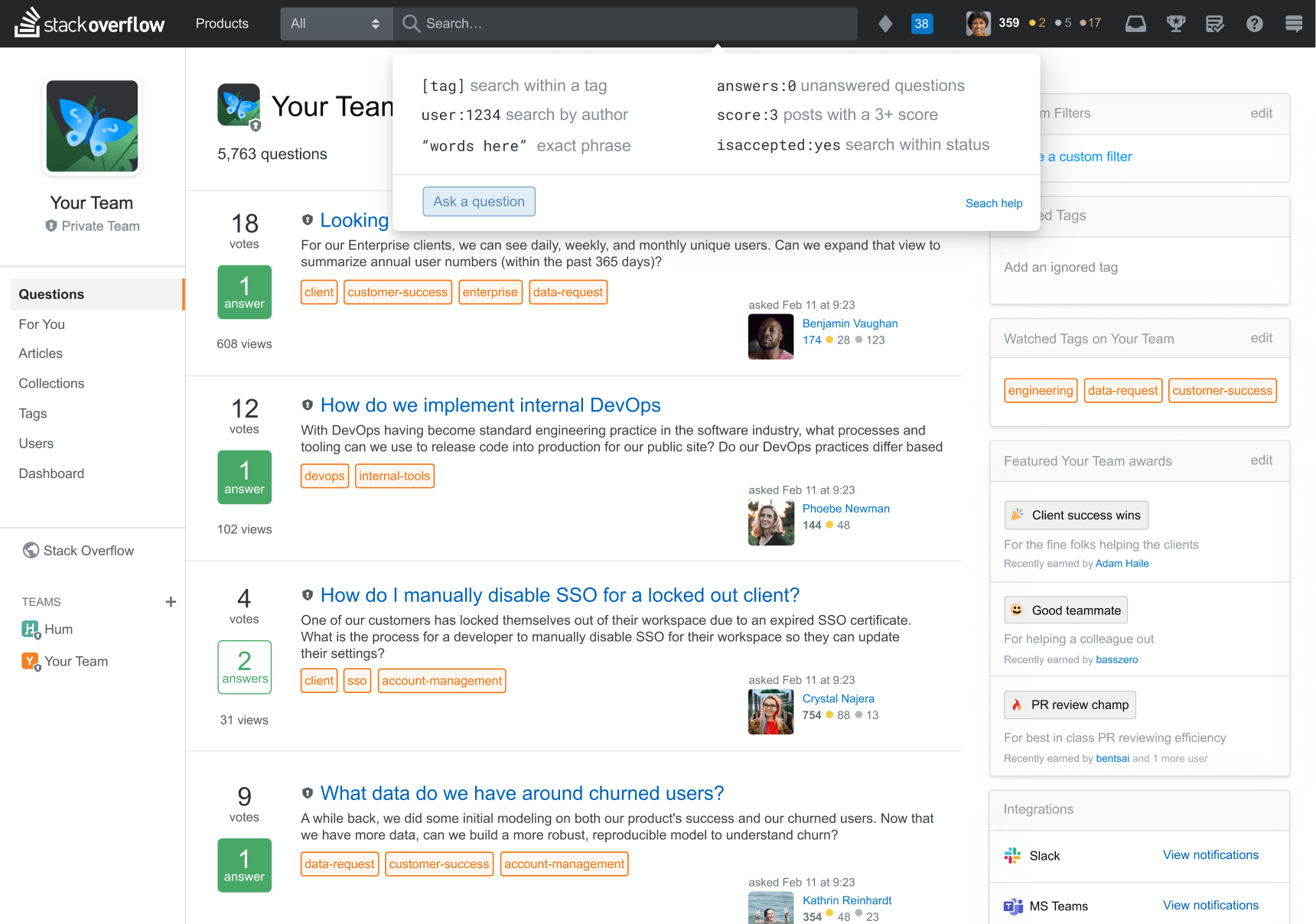
Its answer ranking system, trusted brand, intuitive interface, and huge community has made Stack Overflow a household name for developers. But Stack Overflow for Teams is taking their brand a step further by offering Stack’s signature question and answer interface for private use.
Stack Overflow for Teams integrates with Jira, GitHub, and Microsoft teams as well as Slack and Okta. The Business plan offers content grouping, analytics, and long-form knowledge articles for $12 per user per month.
Pricing
The simplest Stack Overflow plan is always free for up to 50 users. A Basic plan will run you $6/user per month, while their “Business” plan offers content grouping, analytics, and long-form knowledge articles for $12/user per month. Enterprise clients will need to inquire about a custom quote.
Features
- Cataloging and categorization
- Knowledge base management
- Document management
- Remote support
- Self-service portal
- Community forums
8. Zoho Desk
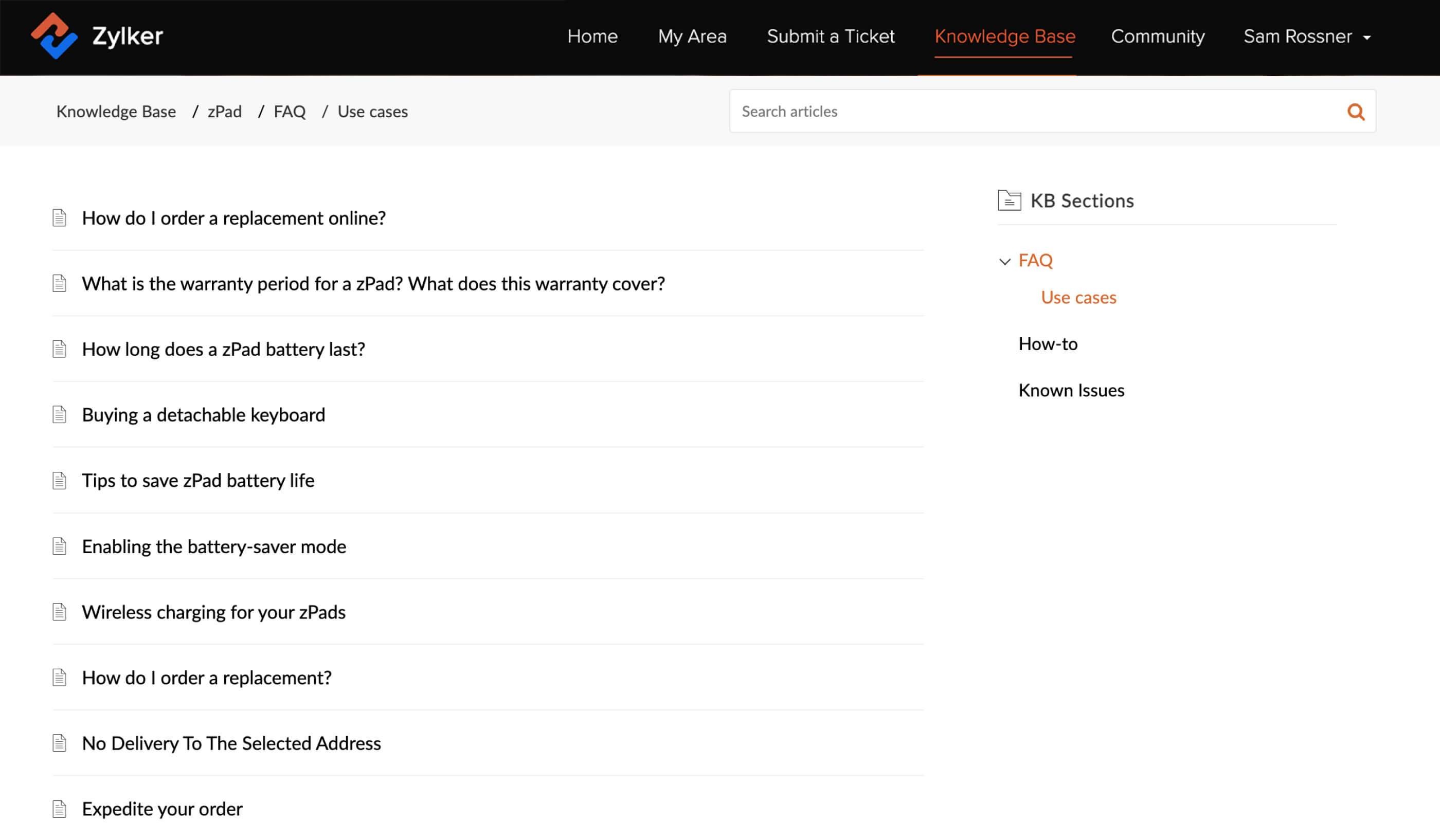
In addition to providing a knowledge base, Zoho Desk also includes a ticketing system and helpdesk solutions. But even on its own, Zoho Desk’s knowledge base is a solid option. The system is easy to use for writers and editors, providing separate categories for how-to articles, FAQs and more.
Zoho Desk’s knowledge base is also flexible; users can set up portals for different customers (internal and external) and use whatever logo or branding they need. Pricing for Zoho Desk starts at $18 per user, per month.
Pricing
Zoho Desk offers a free plan for up to three users, while their standard paid plans start at $14/user per month.
Features
- Portal customization
- Secure access
- Content management
- Text search
- Ticket submissions
- Customer feedback
- Domain mapping
- Advanced reporting
- Chatbots
- Forums and communities
Learn more about Zendesk app for Zoho Desk
9. Document 360

Using Document 360, you can create self-service knowledge bases for your customers and private knowledge bases for your team. Its most powerful features include real-time search, version control, robust categorization, and a file manager. Document 360 also has a clean interface and seamless user experience.
Also, this knowledge base software includes a markdown editor which can simplify content creation.
Pricing
Pricing for Document 360 ranges from $99 to $299 per month for each individual project. The most affordable plan includes two team accounts, with the option to add additional users at $19/account per month. For all of their plans, they offer a 14-day free trial.
Features
- Category manager
- Markdown editor
- Analytics
- User feedback
- SEO
- Content management
- Knowledge base search
- Self-service portal
- Community forums
- Secure file management
Learn more about Zendesk app for Document 360
10. Notion
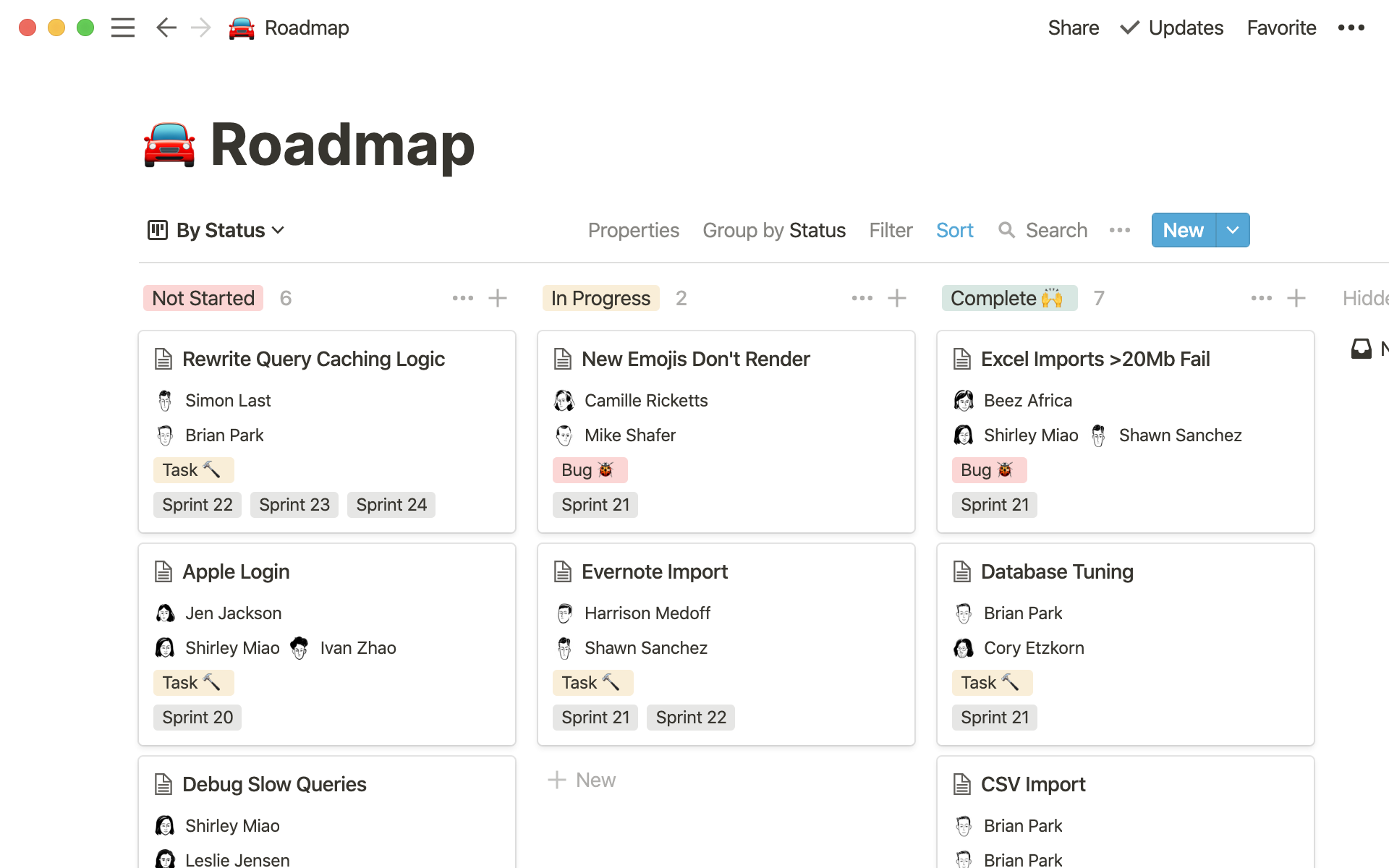
You can use Notion as a database, notepad, project management tool, and/or a collaborative writing space. Because it’s so flexible, Notion is a great option for creating an internal knowledge base. And while it doesn’t have many of the built-in features specific to most customer-facing knowledge base systems, you can technically use Notion to create a self-service knowledge base.
All that said, Notion’s flexibility makes the learning curve fairly steep. It’ll be completely up to you to determine how your knowledge base is organized and labeled.
Pricing
Notion offers a free basic plan for individuals. Its “Team” plan starts at $8/user per month.
Features
- Categorization
- Content management
- Built-in search
- Markdown editor
11. MangoApps

Like Notion, MangoApps lends itself more easily to internal knowledge bases. The software is mainly designed to centralize employee workspaces so customer information is consistent and available when and wherever it’s needed. MangoApps also provides a feature called Libraries which allows companies to organize files, hyperlinks, and other resources into a digital index.
MangoApps’ design is similar to social media apps with threads, comments, and groups. And it provides a broad range of integrations and branding customizations.
Pricing
MangoApps plans require a minimum of 100 users. They offer a free demo and a free 60-day trial period for all plans. To get pricing for MangoApps, you’ll need to talk to one of their representatives for a custom quote.
Features
- Brand customization
- Categorization
- Content management
- Full text search
- Self-service portal
- Customer surveys
- Customer forums
Learn more about Zendesk's integration with MangoApps
12. HappyFox
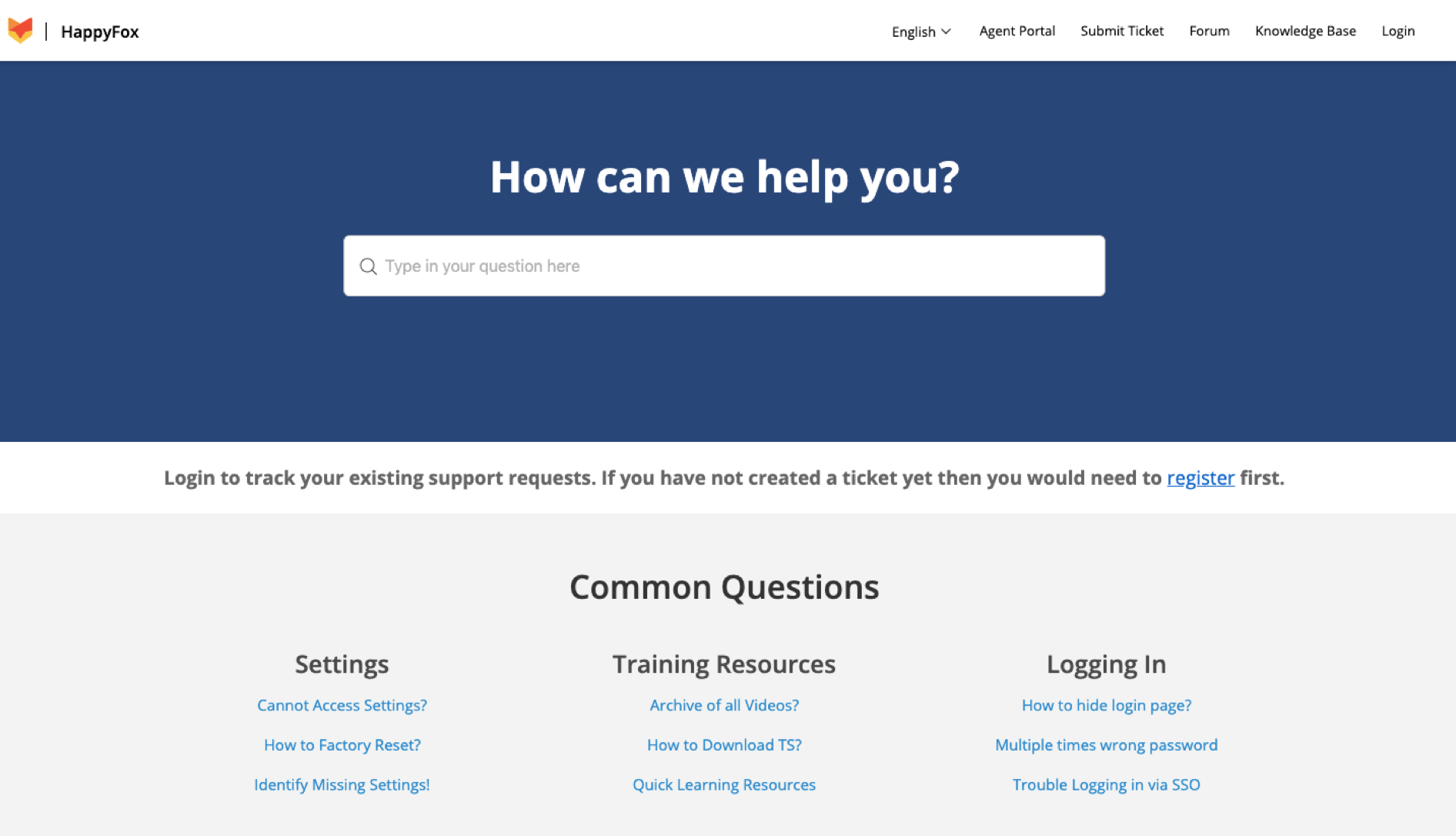
HappyFox is a cloud-based CRM that provides knowledge management systems for many different industries. Their knowledge base provides a host of easy-to-use, powerful capabilities such as multi-brand user portals, feedback collection, and separate internal/external knowledge management systems.
Where HappyFox excels in features, it lags in price and integrations. Still, as a mainstay in the customer service software industry, HappyFox is worth consideration.
Pricing
HappyFox offers a 30-minute demo of their software, but there’s no free option for you to get a feel for the platform. For an average team, price tiers range from $29 to $89/user per month.
Features
- Knowledge base customization
- Categorization
- Rich text editor
- External/internal search
- Auto-suggest
- Self-help portal
- Customer feedback
- Team collaboration tools
- Analytics
- Community forums
Learn more about Zendesk app for HappyFox
13. Slab
Slab bills itself as “a knowledge hub for the modern workplace” designed to unite all the places your team stores information and turn it into a single source of knowledge. Slab features a simple editing interface, powerful search, and solid integrations with popular tools like Google Docs, Slack, and GitHub. It appeals primarily to internal knowledge bases for engineering, operations, and sales teams.
Pricing
Slab does provide a free version for up to 10 users with limited features. Their paid plans range from $6.67/user per month for “Startup” clients, to custom enterprise pricing.
Features
- Categorization
- Content management
- Usage analytics
- Custom domains
- Private and public topics
- Full text search
- Self-service portal
14. Confluence

Confluence is a document collaboration and sharing platform that can be used for internal or external knowledge base purposes. It includes a powerful search engine and keeps track of document changes for easy auditing of content. As just one tool in the enormous suite of Atlassian software, it integrates well with other Atlassian products like Jira Service Management, but has limited service capabilities on its own. It also integrates with over 3,000 Marketplace apps, including common workplace tools like Slack, Dropbox, and Google Drive.
Pricing
Confluence by Atlassian offers a free version for up to 10 users, either in a cloud or data server hosting format (note: server hosting support ends in 2024). For more than 10 users, the standard plan starts at $5.50/user per month, but support is only available during local business hours.
Features
- Unlimited spaces and pages
- Categorization
- Content management
- Full text search
- Macros
- Analytics
- Structured page tree
- Templates
Learn more about Confluence to Zendesk Sync
15. Slite
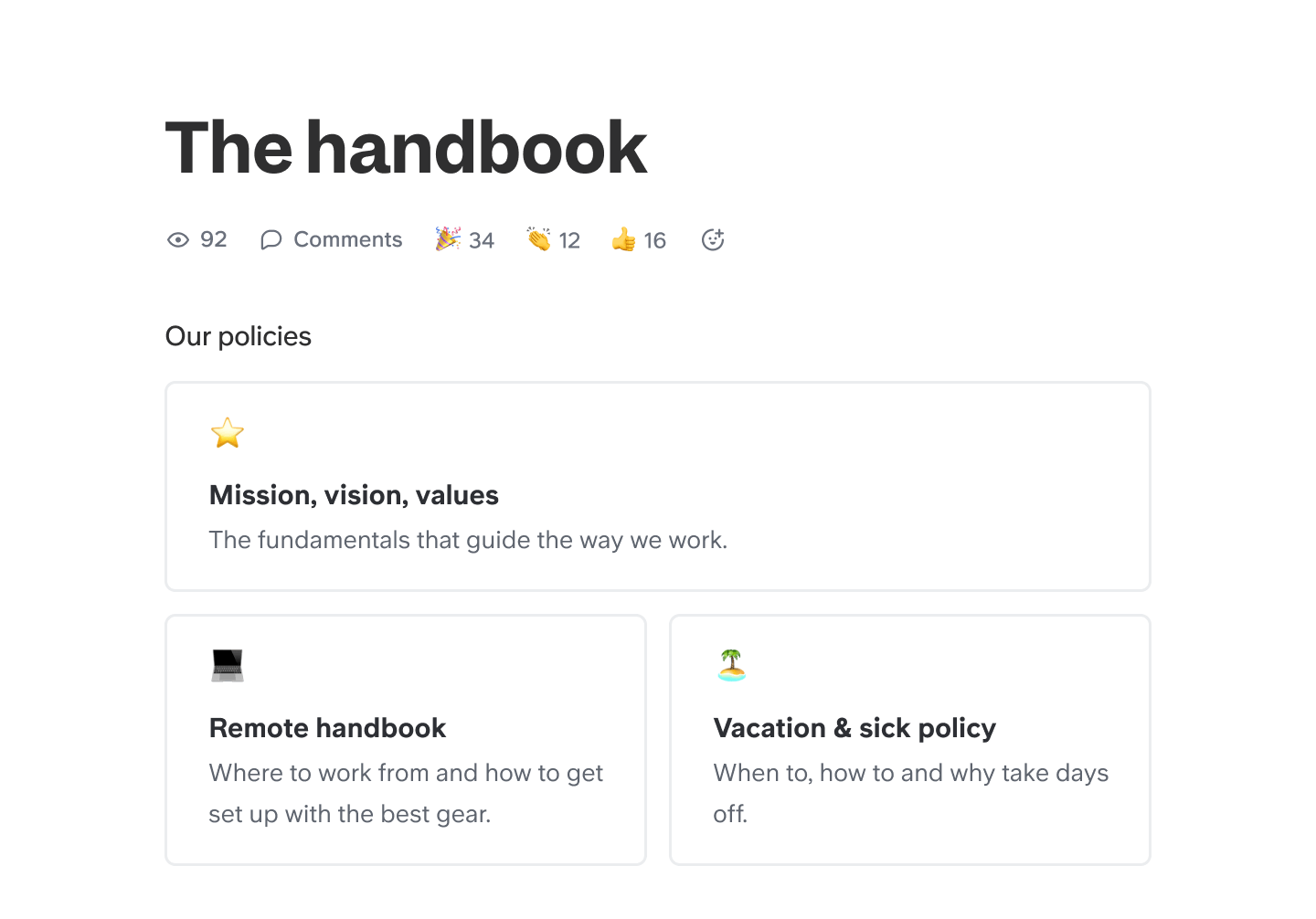
Slite is an internal knowledge management platform intended to centralize and organize important team information. With an intuitive editor, extensive templates, and flexible formatting, Slite sorts information in a beautiful and eye-catching way. Its powerful search feature and common-sense document sorting make information simple to locate and access. It is intended solely for internal data management, however, and is limited as a customer service tool.
Slite includes document activity tracking so you can ensure data is up-to-date. It also integrates with Asana, Trello, Google Drive, Github, Slack, and more.
Pricing
You can try Slite for free with up to 50 supported documents, but if you want unlimited docs the standard plan starts at $6.67/member per month.
Features
- Unlimited documents
- Categorization
- Content management
- Full text search
- Templates
- Realtime collaboration
A comparison chart of top 15 knowledge base software
Knowledge Base Software |
Starting Price |
Free Trial? |
Features |
|---|---|---|---|
Zendesk |
$49/agent per month |
14 days |
|
Wix Answers |
$24/agent per month |
14 days |
|
Intellum Platform |
Customized quote |
X |
|
Bloomfire |
$25/user per month |
X |
|
USU Knowledge Center |
Customized quote |
X |
|
Guru |
Free |
Free for up to 3 users |
|
Stack Overflow for Teams |
Free |
Free for up to 50 users |
|
Zoho Desk |
Free |
Free for up to 3 users |
|
Document 360 |
$99/project per month |
14 days |
|
Notion |
Free |
Free for individuals |
|
MangoApps |
Customized quote |
60 days |
|
HappyFox |
$29/user per month |
X |
|
Slab |
Free |
Free for up to 10 users |
|
Confluence |
Free |
Free for up to 10 users |
|
Slite |
Free |
Free for up to 50 documents |
|
How do you choose the right knowledge base software?
There’s a lot to think about when it comes to choosing the right knowledge base software. The best way to start is to think about the nature of the information you want to organize and the people who will use that information.
Knowledge base software is the tool you’ll use to collect, maintain, and serve the right information to the right person at the right time.
Once you’ve thought about that, consider the following before choosing your tool:
Flexibility and customization
Your team, customers, and existing tools are unique. And your knowledge base software is going to have to support that unique environment. If it’s not flexible, you’ll be forced to patch together and duplicate information in and outside your knowledge base.
Also, if your software isn’t sufficiently flexible, you won’t be able to use the apps, such as chatbots or CRMs, that make knowledge bases even more powerful. So look for knowledge base software that offers an API as well as native integrations to lots of popular tools.
Easy to find and share
Even if your knowledge base is as complete as it can be, its value depends on both agent’s and customer’s ability to find and share information quickly. This makes powerful search and thoughtful categorization features an especially important piece of providing better service and greater agent productivity.
But discovery alone isn’t enough. Knowledge base content also needs to be easy to share with customers and other agents. So look for knowledge management systems that combine discoverability and shareability, and you’ll be ahead of the game.
Seamless collaboration
Much of what makes an effective knowledge base is the ability for multiple employees to contribute. This creates a broader scope of learning for your knowledge base and it makes it easier to incorporate insights gained on the frontlines of customer service into your KB.
So make it a priority to find software that’s intuitive and easy to use for your team. If possible, start with a free trial so you can determine how readily your team will adopt the software. The more comfortable your employees are using the software, the more likely they’ll be willing to contribute.
Frequently asked questions on knowledge base software
Who can use knowledge base software?
Knowledge base software can be used by any person or team who could benefit from consolidating their documents, how-to guides, FAQs, and project/product information in an easily searchable format. If data is centralized and sorted, it’s much easier for employees and customers to find solutions to problems on their own.
Can chatbots be integrated with a knowledge base solution?
Chatbots and other semantic AI assistants can be integrated with knowledge base software in order to exponentially increase the personalization, speed, and accuracy of your self-serve customer experience. Chatbots not only give customers a sense that answers are readily available 24/7, but advances in machine learning mean that chatbots can search for and contextualize solutions in a way that a simple search bar may not. Use Zendesk’s built-in Answer Bot, or connect your own chatbot to Zendesk with our open and flexible integrations.
Why is a knowledge base important?
A knowledge base is an important element in providing self-service options for customers, and it also gives your support team vital information for providing faster, better service. It’s also a great tool for maintaining and communicating essential information to employees.
What can you upload on a knowledge base?
You can typically upload any audio, image, video, or text files on a knowledge base. The only caveat is that some knowledge base software vendors may restrict the size and type of the files you upload.
What software integrations might you need for your knowledge base?
At a minimum, you will likely need software integrations between your knowledge base and your CRM and ticketing system. If you’re currently using live chat, or plan to, you’ll also want to make sure your knowledge base integrates with live chat since referring to knowledge base articles in a chat can significantly improve customer interactions. Others you might need include analytics, messaging, and client portal integrations.
What elements should your knowledge base have?
Every knowledge base should have a system of organization and a text search bar. Beyond that, more specific elements of your knowledge base depend on what your knowledge base is about. For example, if you sell software, your knowledge base should include information that helps customers get started and troubleshoot problems.
How do you keep your knowledge base up to date?
To ensure you keep your knowledge base up to date, follow these three steps:
- Assign the responsibility of managing the knowledge base to someone.
- Designate writers for the knowledge base.
- Establish a process for identifying knowledge base issues.
How can you upgrade your knowledge base?
One of the best ways to upgrade your knowledge base is to use software designed for knowledge sharing, which can make it easy to stay on top of updating articles. The best knowledge management software enables team publishing that allows agents to capture and share their expertise, which uplevels your entire customer support operation.
That software should also allow you to customize how the content is presented, both organizationally and visually. You’ll want knowledge base capabilities that let you incorporate company branding as well as create separate portals in the event your business offers multiple brands.
In addition, powerful AI-assisted features can help surface articles in need of updating and alert your team about information that customers want that your current knowledge base lacks.
How do you transfer your knowledge base to the cloud?
The best way to transfer your knowledge base to the cloud is to use SaaS software designed for managing and maintaining information. The best tools will facilitate the transfer of your existing knowledge base through a migration tool. That tool should enable you to automatically transfer articles by brand; if you have a small number of articles to move, you can copy and paste as needed.
However, you can also employ partner apps to make the process go smoothly, or you can hire professional help to complete the migration.
Should you host your own knowledge base?
While hosting your own knowledge base is an option for your business, it’s wise to consider what that will entail. For example, if your business doesn’t have the staff with the technical know-how to properly host and manage a knowledge base, you’ll have to build that cost into your budget. And if you run into problems, you won’t have much in the way of support to help you overcome problems. Just the day-to-day management of hosting your own knowledge base can burden your team, and you’ll lack many features such as AI assistance.
Try knowledge base software for free
Zendesk is a smart knowledge base that helps you organize your institutional knowledge and put it to work as useful content in the format of a searchable database. Put simply, with Zendesk’s knowledge base, you can quickly create and tailor a help center to your specific needs.
And if you’re already using Zendesk’s ticketing system, you can seamlessly integrate the Zendesk knowledge to level up your customer service operation. So give Zendesk a try and start providing your customers with improved self-service and your agents with greater efficiency and faster resolution.
Tap into more knowledge
Keep exploring the world of community software and knowledge bases.




